Statistics can be used one of two ways:
- To act as evidence and prove a point with dis-regard for the other side of the coin or
- they can objectively explain the facts
285 motorcyclists died as a result of an accident in 2020.
Throughout a year, when National lockdowns were in place and there was significantly less traffic on the roads, 285 bikers still lost their lives on the road.
Those are the objective facts.
Therefore it is vital that we study these figures to see where things are going wrong and what can be done to bring such numbers down even lower.
Using the Department of Transport’s annual report (which was last updated in November 2021), we have pulled the key information together that we think you should know.
It is worth noting that from March 2020, there is a significant correlation in the data between the National lockdown restrictions implemented and the number of road traffic accidents overall.
With fewer vehicles on the road, the number of accidents decreased.
- There were an estimated 1,390 reported road deaths in the year ending June 2021, a decrease of 11% compared to the year ending June 2020.
- There was a decrease of 22% compared to the 3 rolling year average for 2017 to 2019.
With that in mind, let’s get into the key points.
Save Money On Your Motorcycle Insurance
- You could pay less than £195*
- Compare quotes from 25+ UK providers
- Fill in one form to compare top bike insurers
Key Findings
Do motorcyclists have more accidents than other vehicles?
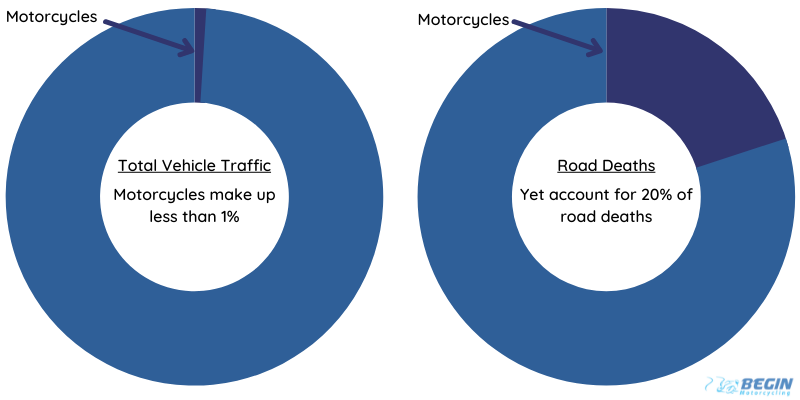
Motorcyclists are a highly vulnerable group and make up a significantly low amount of motor vehicle traffic on UK roads, yet have a high fatality and casualty rate.
In 2013 it was estimated that motorcycles make up just 1% of total motor vehicle traffic. By 2018 this had decreased to just 0.8% of all motor vehicle traffic. However, motorcyclists accounted for 20% of all road deaths in 2020.
Key Finding
Motorcycles make up just 1% of total motor vehicle traffic yet accounted for 20% of all road deaths in 2020.
Since 2017 this has been consistent with motorcyclists making up between 19%-20% of all road deaths each year while making up less than 1% of all motor vehicle traffic.
Car occupants made up 55% of all fatalities, serious and slight casualties in 2021.
Motorcyclists accounted for around 13%.
Key Finding
Cars and taxis travelled 209.6 billion vehicle miles in 2020; that’s 98.8% more distance than motorcycles travelled, and there were just 669 car occupant fatalities to 291 motorcyclist fatalities.
To put things in a bit more perspective, pedal cyclists travelled 5.0 billion vehicle miles in 2020 compared to motorcyclists 2.5 billion vehicle miles.
However, there were 126 pedal cyclists killed in accidents compared to 291 motorcyclists killed in the same period.
Key Finding
Motorcyclists travel less distance on UK roads yet have over 50% more fatal accidents than pedal cyclists.
This figure is starkly illustrated by the following graph, which shows the fatality rate per billion miles for each vehicle type:
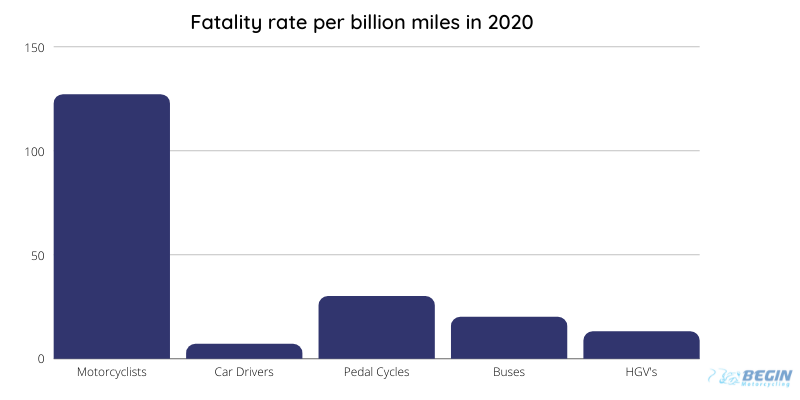
How many motorcycle accidents are fatal?
In 2021 1.9% of all motorcycle casualties were fatal.
Out of 14,690 casualties, 280 of those resulted in death.
In 2018 and 2019, the percentage of fatal accidents was around 2.1%. Before this, the last time the rate of fatal accidents was higher than 2% was in 2010.
Comparatively, the number of car accidents that have resulted in occupant fatalities hasn’t risen above 1% in the last 5 years.
This information is a stark reminder that motorcyclists are at more risk of death in the event of an accident than car occupants.
How many motorcycle accidents result in severe injury?
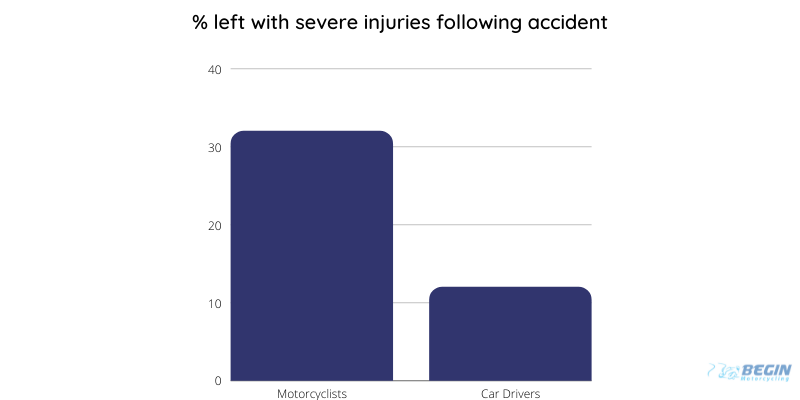
Unsurprisingly motorcyclists are more likely to suffer severe injuries in an accident than car occupants.
In 2021 around 12% of car accidents resulted in the occupants suffering severe injuries. However, 32% of motorcycle accidents resulted in riders being left with severe injuries.
Key Finding
32% of motorcycle accidents resulted in riders being left with severe injuries.
However, the good news is that severe injuries resulting from motorcycle accidents have decreased by 48% from 2004-2020.
Have the number of motorcycle accidents changed over the years?
The number of motorcycle accidents has changed over recent years, and on the whole, there has been a decrease in the number of casualties.
The following information applies from July-June each year.
- For 2021 there was a 19% decrease in the number of motorcyclists killed compared to data in 2017-2019; there was a 3% decrease for the same time period in 2020.
- There was just a 17% decrease in the number of motorcycle casualties (of any nature, severe or slightly injured) when compared to 2017-2019; but a 5% increase in the number of casualties for 2021 compared to 2020.
- When you look at all casualties for car occupants in the same way there was a 32% decrease compared to 2017-2019, and a 13% decrease in 2021 compared to 2020.
It is perhaps shocking information that for 2021 the base average of casualties increased compared to 2020, whereas car occupant casualties decreased even further.
Of course, it must be noted that lockdown restrictions were lifted for part of 2021’s data collection, and so there would have been more riders on the road, but the same is true of car occupants; what this data does is show just how vulnerable motorcyclists are.
Key Finding
When both motorcycles and cars were moving around more freely post-lockdown, the number of motorcyclist casualties almost immediately started to increase again.
How have things Improved?
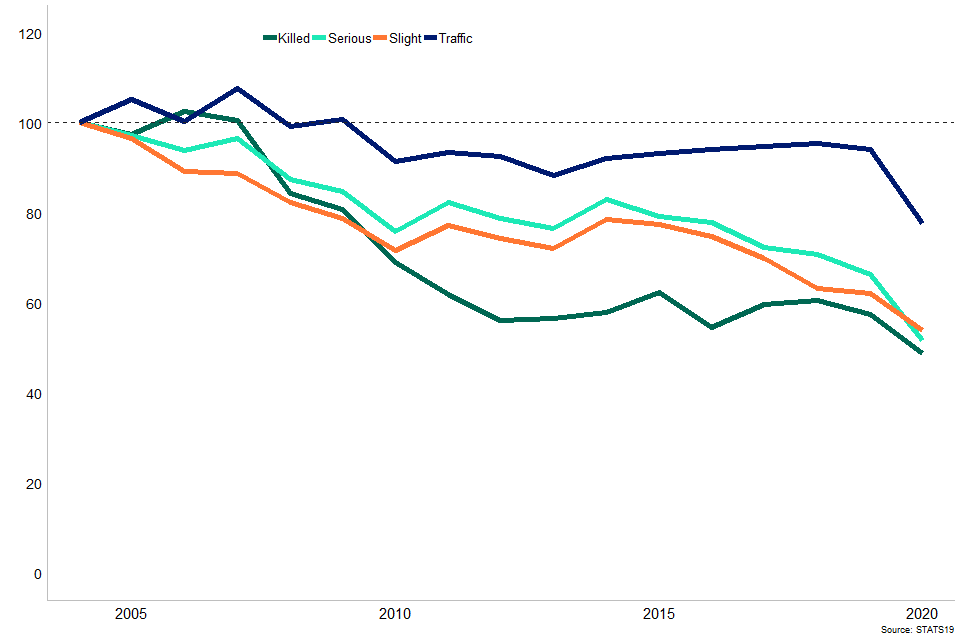
Key Findings
A 51% decrease has been seen in motorcyclist deaths from 2004-2020.
The number of serious injuries has also fallen by 48%.
Pre-Covid, the figures were looking hopeful: the total number of casualties for 2017 was 19,066 by 2019 this had decreased to a total of 16,733 for that year, which is 2,333 less.
For 2021 even with an increase over 2020’s numbers, there were still significantly fewer casualties than 2019, with a total figure of 14,690.
Between 2004 and 2020, motorcycle traffic has actually fallen by 22%.
This will undoubtedly play a role in why accidents have decreased.
In 2020 alone, motorcyclist traffic fell by 18%, and fatalities fell by 15%.
The turning point seemed to be 2014, when each year until 2020, motorcycle casualties fell.
Therefore, the hope would be that from 2021 onwards, motorcycle casualties will stabilise and then continue to fall year on year, as was the trend pre-pandemic.
The numbers for 2021 will be released in June 2022.
What is the most common type of motorcycle accident?
There are some key points to acknowledge when it comes to types of motorcycle accidents gathered between 2015-2020:
- 33.9% of all seriously injured and 37.3% slightly injured casualties occur at or within 20m of a junction
- 58% of all fatalities do not occur at or within 20m of a junction
- 40% of motorcycle fatalities where there are 2 vehicles involved, involve a car
- 66% of motorcycle fatalities occur on rural roads
The most common factor where motorcyclists have been involved in fatal or serious accidents with another vehicle was that the ‘driver or rider failed to look properly’.
Following this, the second most common contributory factor was that the ‘driver or rider failed to judge other person’s path or speed’.
The driver or rider being careless, reckless or in a hurry was the third most relevant factor to fatal or serious accidents.
The highest proportion of fatal casualties from a 2 vehicle accident was when an HGV was involved (8.3%). The second-highest proportion of fatalities was when 2 or more vehicles were involved.
The time of day also reflects a pattern in the number of accidents that occur.
Key Finding
Between 4 pm and 7 pm is the peak time for a motorcycle collision Mon-Fri, whereas Saturday and Sunday, the peak time is from 12 pm-4 pm.
Are more men or women involved in the most motorcycle accidents?
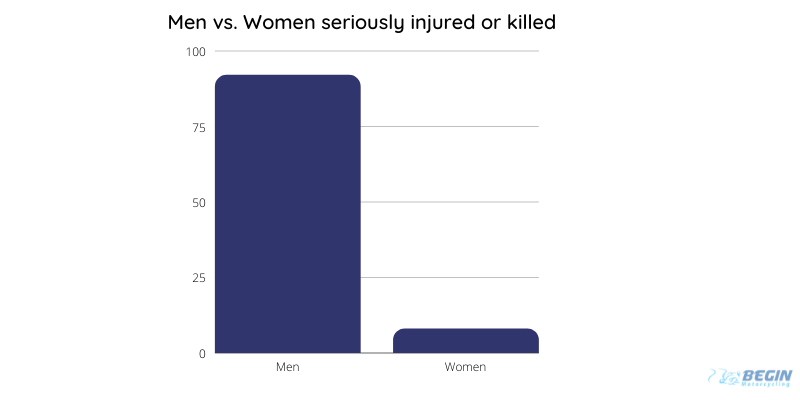
According to the Reported Road Casualties Factsheet, 92% of motorcycle killed or seriously injured (KSI) casualties were male between 2015-2020.
There were 12 times more male casualties than female casualties involved in motorcycle accidents.
This aligns with the National Travel Survey, which states that 86% of motorcyclists are male, so it is no surprise that there are more male casualties.
Do they tell us anything else?
- Male riders aged 30-39 are more likely to be involved in an accident, followed by male riders aged 20-24
- In 2020 motorcycles travelled 2.5 billion vehicle miles compared to 209.6 billion vehicle miles for cars
- The most common type of road that motorcyclists ride is Minor Roads with 1.4 billion vehicle miles having been travelled in 2020
- The amount of annual motorcycle traffic has decreased since 2007
What do the statistics tell us?
We have thrown a lot of numbers at you, and even though we have pulled out the key pieces of information, it can still feel like a bit of an overload.
So let’s break it down without the numbers and percentages:
- There are less motorcyclists on the road than cars, however motorcyclists are involved in more accidents resulting in death or serious injury
- The rate of a collision being fatal involving a motorcyclist is higher than that of car occupants
- The number of fatalities and severe injury casualties has decreased significantly since 2004
- There are more male motorcyclists than female, and therefore more male motorcyclists are involved in collisions that are fatal or cause serious injury
- Accidents at junctions are where motorcyclists are most likely to be seriously or slightly injured
- Fatal accidents however are less likely to occur at or near a junction
- The majority of fatal motorcycle accidents involve other vehicles and occur on rural roads
- Rush hour evening traffic is the worst time for motorcycle accidents in the week and afternoon rides on the weekend
Statistics are tricky as they can easily be manipulated to paint a bleak picture to prove a point.
However, they also don’t lie. It isn’t hard to see just how vulnerable we are as motorcycle riders by objectively comparing the same numbers to car occupants or even pedal cyclists.
Knowing where the most common accident takes place at a junction for serious or slight injury means that we can take extra care in those situations, and when riding on rural roads, we will be more conscious of our speed and the way we ride.
Particularly knowing that the most common factor of an accident is that the driver or rider failed to look correctly, will ensure that we take that second glance and do our lifesaver checks.
Riding a motorcycle is not just a means of transport. It is a pass to the definition of freedom for most of us, as cliche as that may be.
Utilising this sobering information will hopefully go some way to help keep us safer on the road.
Data Sets and sources
Department of Transport’s annual report
Reported road accidents, vehicles and casualties tables for Great Britain
Motorcycle fact sheet
